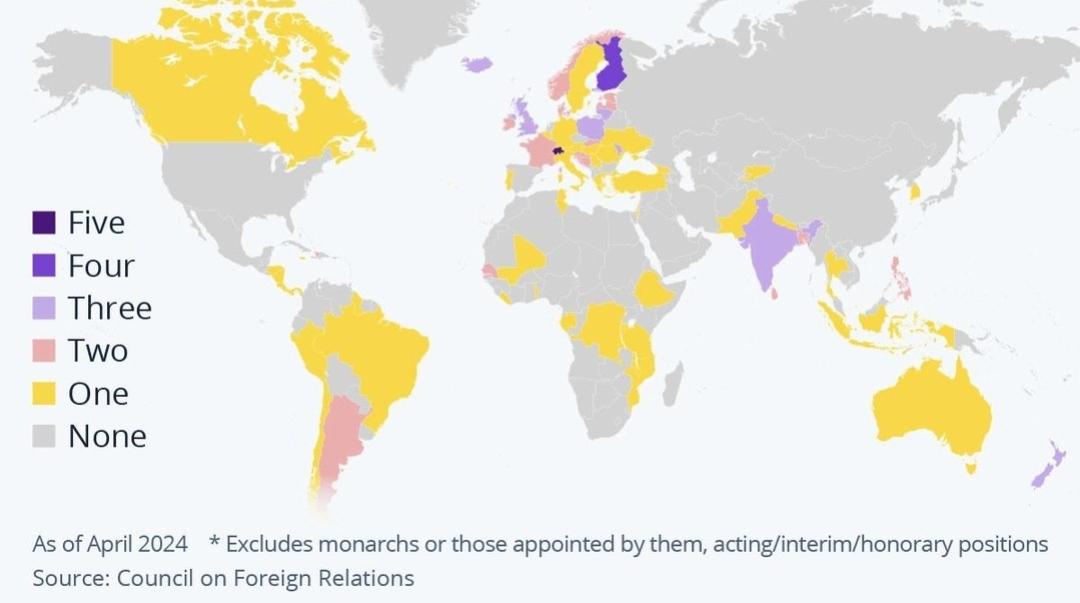Map of Countries Led by Females Since UN Creation


Alex Cartwright
Senior Cartographer & GIS Specialist
Alex Cartwright is a renowned cartographer and geographic information systems specialist with over 15 years of experience in spatial analysis and data...
Geographic Analysis
What This Map Shows
This map illustrates the countries that have been led by female leaders since the establishment of the United Nations in 1945. It highlights a significant aspect of political leadership and gender representation across the globe. The visualization provides a clear depiction of female leadership in various nations, showcasing both the historical and contemporary landscape of women in power. As we delve deeper into the topic, it’s essential to recognize how these female leaders have influenced their countries and the global stage.
Deep Dive into Women in Leadership
Women have historically faced numerous barriers to political power, but the last few decades have seen a remarkable shift. The presence of female leaders in politics is not merely a trend; it represents a profound change in societal norms and expectations regarding gender roles. Ever wondered why certain countries are more progressive in electing female leaders? Factors like cultural attitudes, electoral systems, and gender quotas play a crucial role in shaping the landscape of women in leadership.
Interestingly, countries like New Zealand, Germany, and Liberia have made headlines for their female leaders. For instance, Ellen Johnson Sirleaf, the former president of Liberia, was the first elected female head of state in Africa, serving from 2006 to 2018. Her leadership not only transformed Liberia post-civil war but also inspired many women across the continent to pursue political roles.
Moreover, countries such as Finland, with its current prime minister Sanna Marin, and Denmark, led by Mette Frederiksen, are often highlighted for their progressive gender policies and high rates of female political representation. The Nordic model, which emphasizes gender equality, has resulted in women occupying nearly half of the parliamentary seats in these nations. Statistics show that countries with higher female representation often enjoy better governance and more inclusive policy-making.
The map also reflects the evolving nature of leadership, with women not only in traditional roles but also in positions typically dominated by men. Countries like Bangladesh, under the leadership of Sheikh Hasina, have demonstrated how female leaders can navigate complex political landscapes, often leading their nations through crises with resilience and innovation.
Regional Analysis
Examining the map regionally reveals compelling narratives about female leadership. In Europe, several countries have embraced female heads of state, with Germany and Finland leading the way. The European Union has also pushed for gender equality initiatives, encouraging member states to appoint women in leadership roles.
In Africa, the presence of female leaders is notable, particularly in the southern region, where countries like Namibia and Malawi have made significant strides in gender representation. However, the challenges remain; many nations still face societal and institutional barriers that hinder women's political participation.
Conversely, in Asia, countries like Sri Lanka and India have seen female leaders rise to prominence, yet cultural norms often limit the extent of their influence. It's fascinating to observe how historical contexts and societal structures shape the political landscape differently across regions. For instance, while India has had female prime ministers, the broader societal challenges of gender inequality remain prevalent.
Significance and Impact
The significance of female leadership extends beyond mere representation; it influences policy decisions and societal norms. Countries led by women often prioritize issues such as education, healthcare, and social welfare, reflecting a more holistic approach to governance. The impact of these leaders can be seen in various sectors, from environmental policies to human rights advocacy.
As we look to the future, the trend of increasing female leaders seems promising. Initiatives aimed at empowering women politically are gaining traction worldwide, with organizations advocating for gender parity in leadership roles. Projections indicate that by 2030, we may witness an even greater number of women in political office, particularly if current trends continue.
In conclusion, this map serves as a powerful reminder of the progress made and the journey ahead in the quest for gender equality in leadership. The stories behind these female leaders are not just about politics; they are about changing the very fabric of society, inspiring future generations to break barriers and lead with conviction.
Visualization Details
- Published
- October 22, 2025
- Views
- 26
Comments
Loading comments...